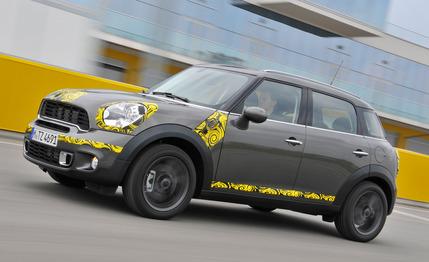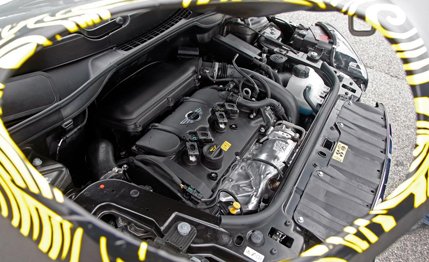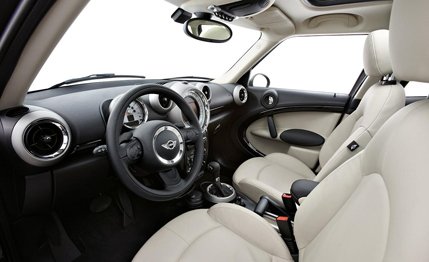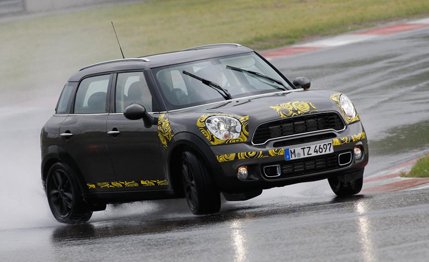 Prototype Drive
Prototype Drive
There’s a theme to the new Mini Countryman: four. Four passenger doors, four-wheel-drive, four seats, four cylinders, four wheels—okay, maybe that last one’s a bit of a stretch. Of course, nothing embodies that theme as well as Bobby Orr’s legendary 1970 Stanley Cup goal—he wore number four, and it was scored 40 seconds into the fourth period of game four to win Boston’s fourth Stanley Cup—but the four-door Countryman is nonetheless a big deal for Mini. It’s the first time a Mini has come with so many doors. And it’s an effort to lure in more buyers to the Mini brand, by recapturing former owners who have outgrown the diminutive brand’s lineup and by adding new customers who previously dismissed other Minis for being too small.
But if you’re worried that Mini has sold out its identity in search of a bigger market with the Countryman, well, fear not. The big Mini is over 16 inches longer than the Mini Cooper hardtop but still 3.6 inches shorter than a Volkswagen Golf. This means the largest Mini ever is still pretty small. And more important, the Countryman still feels like a Mini.
Supersizing It
The Countryman is to the rest of the Mini lineup as anything American is to its European counterpart. Take our refrigerators, for example. The basic operating principle, a box in which to keep your vegetables, meat, and beer cold, is the same as in Europe. It’s just that the American fridge is scaled up one size. Such is the case with the Countryman. It’s longer, wider, and taller than the Cooper hardtop and the Clubman, but it still looks like a Mini. There are some subtle changes, like the oval headlamps that have been squared off, but the Countryman fits in visually with the rest of the Mini family.

The interior, although unique to the Countryman, is easily recognizable as that of a Mini as well. Oval-shaped door cutouts like those in the smaller Minis are stretched out along the front and rear doors. And rear-seat power windows are operated via a toggle switch, just as in the front. The Countryman’s biggest feature, aside from the four doors, is its center rail system that runs between the front and rear seats and can accommodate everything from an armrest and sunglasses holder to as many cup holders as you want to buy. And speaking of rear seats, the Countryman will only be available in the U.S. with a four-passenger configuration—Mini cites our stringent crash standards as the reason for a lack of an optional rear bench. The rear seats fold flat and travel fore-and-aft 5.1 inches.
The Countryman’s H-point is 2.8 inches higher than in the other Minis, and the raised driving position is noticeable. Mini might market the Countryman as an alternative to small crossovers, but the feeling is definitely carlike. Shoulder room is four inches wider in the front seats, and the extra elbowroom is nice. Think of the Countryman as a Mini you can actually stretch out in. The width difference is even more apparent in the back seat, with 7.6 more inches of shoulder space than in the Clubman. And all seating positions are more chairlike; your knees are at hip height instead of above. Still, six-footers will need to slouch in the second row to keep their hair from brushing the roof. Our exposure was limited, but it looks like all four seats in the Countryman are adult-friendly, even for long trips.
As one would expect, the Countryman comes with more space for cargo: 12.4 cubic feet in the smallest configuration and 41.3 cubic feet at maximum capacity. As in the Clubman, there’s a false load floor with extra storage underneath. And taking a cue from the BMW 5-series Gran Turismo, the Countryman has a foldable vertical wall that closes off the luggage compartment from the rest of the cabin.

Engine Enhancements
The Countryman goes on sale early next year in three different versions: base Countryman, turbocharged Countryman S, and top-banana all-wheel-drive (another first for Mini) Countryman S All4. The engines are the same as in the rest of the Mini lineup and share the updates and power increases that all Minis receive for the 2011 model year.
The 1.6-liter in the base Countryman is rated at 121 hp, an increase of 3 hp. Major changes include an electronically controlled oil pump that is no longer tied directly to engine speed, a switchable water pump, and internal friction reductions. Torque gets a four-unit bump (hey, another four!), up to 118 lb-ft.
Both S versions come with the turbocharged version of the 1.6-liter, which gets the aforementioned upgrades and now features BMW’s Valvetronic system in addition to variable intake- and exhaust-valve timing and direct injection. Valvetronic uses variable lift—in the Countryman it ranges from 0.2 to 9.0 mm—to control the volume of air going into the cylinders. This eliminates the need for a throttle butterfly and improves efficiency and engine response. Output is increased to 181 hp, up 9 hp, and torque goes from 177 lb-ft to 192. As an added bonus, the turbocharged Countryman achieves almost the same combined fuel-economy rating as the naturally aspirated version in the European combined cycle. EPA figures haven’t been announced yet, but Mini is hoping the cars will achieve nearly 34 or 35 mpg on the highway.
Transmissions, like the engines, are the same as those used in the rest of the lineup, with some enhancements. The six-speed manual now has heavy-duty carbon synchros in all gears, new shift cables, a self-adjusting clutch, and a dual-mass flywheel. The six-speed automatic adds a neutral-idle control feature that basically shifts the transmission out of gear at a stop when your foot is on the brake pedal. The shift logic also now has a “stop and go” mode that holds second gear for smoother movement through traffic jams.
Not shared with others in the Mini lineup is the Countryman’s four-wheel-drive system, branded All4. A wet multiplate clutch at the rear axle, developed specifically for Mini by GKN, controls the amount of engine torque sent aft. The Countryman operates as a front-wheel-drive car in normal driving, although the rear prop shaft is always rotating. As soon as the front wheels spin faster than the rear wheels, a ball ramp inside the differential forces a small pilot clutch to automatically engage and send torque rearward. If the slip continues, a servo acts to send up to 50 percent of the engine torque to the rear.
The Mini That Drifts
We spent some time on a wet test track driving a Countryman S All4 with a manual transmission. The good news, as we mentioned before, is that the Countryman still feels like a Mini: responsive and agile. The even better news is that with all-wheel drive and stability control switched fully off, the Countryman is capable of power oversteer, increasing the hooligan potential beyond that of front-wheel-drive Minis. We didn’t have a chance to fully evaluate the Countryman, but our early impression is that it’s slightly softer than the rest of the Mini lineup, with slightly slower steering and a bit more body roll. The ride is a lot like your average American: a bit soft but very affable. Anybody familiar with the bone-jarring suspension in other Minis, like that of our long-term Mini JCW convertible, will find the Countryman’s ride to be sweet relief.

Stacking Up against the Competition. Wait, What’s the Competition?
The Countryman shares a similarity to other Minis with its incongruity to the rest of the market. Mini wants the Countryman to compete mostly against small crossovers like the Subaru Forester, Nissan Rogue, Toyota RAV4, and Volkswagen Tiguan. It should at least compete well on price. We’ve been told the Countryman will start at a base price between that of the Clubman and convertible, or about $24,000. We’re guessing an upgrade to the S model will be about $3000, and all-wheel drive should cost another two grand, give or take. But of course there will be hundreds of small customization options that are sure to inflate the sticker price even further. The issue is that the Countryman is generally underpowered (especially the base model) and slightly smaller than the vehicles listed above; the Tiguan, for instance, is 12.5 inches longer. Size-wise, the Countryman is almost an exact fit with the Volkswagen Golf, which starts at a much lower base price.
So on a strictly empirical level, the Countryman doesn’t stack up, but neither have the other Minis, and that hasn’t hurt sales. In fact, Mini remains an anomaly in the U.S. market as the only successful premium-priced compact car. The good news for Mini is that the Countryman should be able to pull off the same feat. It’s bigger, but the Countryman retains the fun character of the rest of the brand in design and driving experience.